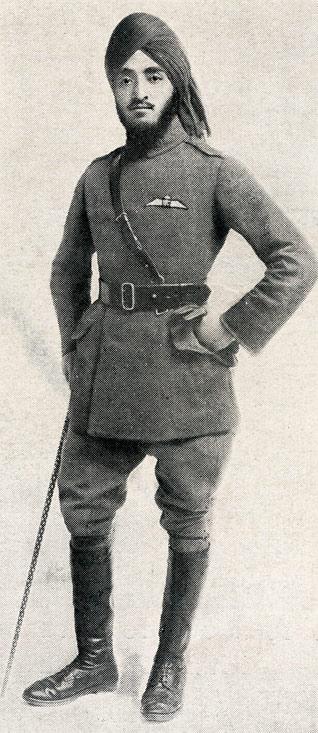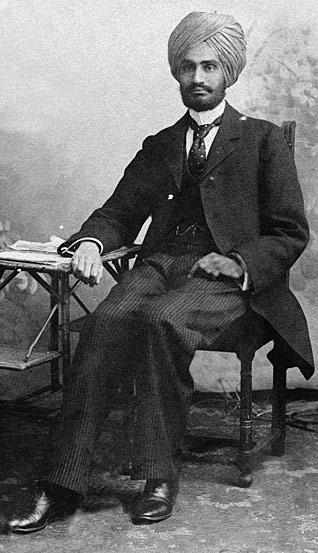Columnists
Sikhs in Britain
A Book Review by MANJYOT KAUR
THE SIKHS IN BRITAIN: 150 Years of Photographs, by Peter Bance. Sutton Publishing Ltd., U.K., 2007. ISBN 978-0-7509-4511-0. 192 pages. Price: £18.99.
Enhanced by over two hundred black-and-white photographs, many of them taken from private collections and never before published, The Sikhs in Britain is an absorbing visual history of Sikhs and their contribution to British society, from the mid-nineteenth century to the present day.
Its author, also known under his full name of Bhupinder Singh Bance, is an independent researcher, specializing in Anglo-Sikh history.
Two Forewords, one by Captain Amarinder Singh, the Maharajah of Patiala, and the other by internationally-renowned filmmaker Gurinder Chadha, begin this book. They are followed by Acknowledgements, Picture Credits, and a Chronology of events of Sikh significance, from 1469 to 2006.
In his Introduction, after saying a few words on the origins of Sikhism and the inception of British-Sikh relations in India at the time of Maharajah Ranjit Singh, Peter Bance presents a thumbnail overview of life in Britain for the Sikhs - the first community to migrate in large numbers to the United Kingdom from the Asian subcontinent - starting with a son of Ranjit Singh, Maharajah Duleep Singh, who arrived in England in 1854.
Subsequently, Sikh soldiers participating in imperial processions or convalescing from military campaigns, together with lascars (Indian sailors employed by the East India Company), were among the early travelers to Albion's shores in the late 19th and early 20th centuries.
Bance then outlines the four significant stages of Sikh migration to Britain that followed. An influx of businessmen, students and peddlers came in the period between the two world wars, with another wave arriving after India's partition in 1947.
Increasing numbers, many of whom were subjects of former British colonies, entered in the 1950s, to be joined later by emigrants from East Africa, such as those expelled from Uganda in the 1970s.
It is estimated that over a million Sikhs now call the United Kingdom home.
A pair of maps, entitled "The Present ‘Punjab State'" and "British India in 1947", follow the Introduction.
Much of Chapter One, on early Sikhs in Britain, explores a subject on which Bance is a noted authority: the Duleep Singhs, the first Sikh family to reside there permanently. An array of fascinating photos of the Maharajah and his entourage (many of which appeared in the author's first book, The Duleep Singhs), make up the illustration section of this chapter, along with some impressive snapshots of Sikh military men, and a glimpse of Sardar Bahadur Bhai Ram Singh, the father of modern Sikh architecture.
Chapter Two deals with other Sikh maharajahs and various wealthy nobles who came to England. Among the most frequent visitors were Maharajahs Bhupinder Singh and Jagatjit Singh, members of the ruling houses of Patiala and Kapurthala, respectively. They were soon joined by scions of royalty from Nabha and Jind.
This chapter's illustrations, showing the blue-blooded crowd taking a spin in their Rolls Royces, togged out in jaunty hunting tweeds, and engaging in other leisurely pursuits, paint a vivid picture of the opulent lives of luxury they and their families led, not only back home, but also in Britain.
The gallant Sikhs who valiantly fought for the Allies in both World Wars are featured in Chapter Three. No less than 100,000 Sikh soldiers took part in World War I; more than 12,000 of them were decorated with awards for bravery, including the Victoria Cross. Similarly, World War II gave ample first-hand evidence of Sikh martial prowess, both on the ground and in the air. Numerous snapshots of handsome, turbaned men posing in uniform impressively portray these 20th century Sikh warriors.
Bance highlights the period from the 1920s to Indian independence in 1947 in Chapter Four.
While numerous Sikh migrants to England during this time came with the intention of a brief stay, many of them ended up
remaining as permanent residents, finding Britain a better environment in which to bring up their children, despite discrimination (whether for the color of their skin, or the turbans they wore) that often forced them to settle for the occupations of peddler or laborer.
Although they plied their various trades all over Britain, even reaching the rural areas of Scotland, Wales and Ireland, urban areas such as Manchester were considered most desirable. Regardless of what job they held, Bance's photos invariably show off their sartorial splendour, with natty suits topped by smartly-tied turbans.
In Chapter Five, Bance discusses the Sikhs who flocked to Britain after India's partition, finding a booming postwar economy in need of labor to help rebuild the country. The resurgence of foundries and factories, especially those connected with textile manufacturing, provided ample opportunities for employment in England's industrial sector.
Many large group portraits, at weddings or posed outside gurdwaras, effectively demonstrate the great increase in Sikh population during this time.
A topic otherwise largely absent from the book gets a very welcome, albeit brief, treatment in Chapter Six ("The 1960s"): female Sikh immigrants. Many women and girls began to arrive in Britain during this period, as growing numbers of resident Sikh men, who had already established themselves in the U.K., started sponsoring their wives and children to join them.
Entire family units also came from the newly-independent East African nations of Kenya, Uganda and Tanzania, previously home to one of the largest populations of Sikhs outside India.
The important national issue of the right of Sikh transport workers to wear turbans on the job is also discussed here. Group shots of families, literally just off the plane, and several impressive portraits of bus and Underground workers, company badges pinned to their dastaars, illustrate this section.
In Chapter Seven, Bance brings up the history of English gurdwaras, starting from their initial establishment in 1906. As the Sikh population grew over the ensuing decades, a pattern of community gurdwaras emerged, usually divided by trade caste or geographical origin.
A most unusual picture, taken in 1954, appears in this section: a notably-mixed sangat, including many Englishmen and women of non-Punjabi origin (the caption, unfortunately, does not tell us the details of their presence), clustered around a female granthi.
Like the 1960s, the 1970s, which Bance discusses in Chapter Eight, also saw a "Right to Turban" case - this time, to enable Sikhs to ride motorbikes wearing dastaars instead of crash helmets.
As was also true of the previous decade, Punjabi music became increasingly popular in Britain during this period.
A photo of a most unique personage - Elvis impersonator Narinder (Peter) Singh - as well as one of a motorcycling Sardar, proudly sporting not only a turban, but an enormous garland of flowers, are among the highlights of this section.
In Chapter Nine, Bance takes the reader from the 1980s up to the present day. With the unofficial Sikh population estimates in Britain now topping the million mark, boosted by a mass influx from Afghanistan, Bance stresses the great extent to which the new British-born generations have integrated into all spheres of mainstream English life, successfully competing for jobs at the highest levels of every profession.
Photos of Prince Charles unveiling a statue to commemorate the centenary of the death of Maharajah Duleep Singh, the Singh Twins (artists Amrit and Rabindra Kaur Singh), a poster for the "Arts of the Sikh Kingdoms" exhibition at the renowned Victoria & Albert Museum, Britain's first Sikh female Justice of the Peace, as well as world-class sportsmen Monty (Mudhsuden Singh) Panesar and Fauja Singh, are just some of the images Bance uses to effectively emphasize the extent to which Sikhs have entered every area of contemporary British society.
A short Glossary and Bibliography, as well as a section of Notes and an Index, form the final segments of this work.
With 150 years of history behind them, what possibilities lie ahead for the Sikhs of Britain?
A concluding chapter, discussing this and many other questions the reader might have, would have provided a satisfying wrap-up to this book. However, it is evident that offering detailed, in-depth analyses is not meant to be the purpose of this work.
It admirably succeeds in fulfilling its mission of visually charting the path by which Sikhs have become an integral part of the social fabric that is multicultural Britain. Its strength lies in the undeniable impact of its veritable treasure-trove of photographs.
By rescuing these captivating images from obscurity and presenting them in a logically-arranged and eye-catching fashion, Peter Bance has created an impressive historical record, sure to be of great appeal to a wide audience.
[Photos: Bottom of this page - Filmmaker Gurinder Chadha. Second from bottom - Balwant Singh was called to the bar at Lincoln's Inn in 1896, and was followed by eleven members in his family in the practise of law. Third from bottom - Malik Hardit Singh, CIE, OBE, ICS, 1918: he served as a wartime pilot with both the French Air Force and Britain's Royal Flying Corps during the First World War, and was involved in airfights against the legendary "Red Baron"; later, he gained further fame as Prime Minister of the PEPSU state (Patiala & East Punjab States Union - one of the earliest predecessors of the current Indian Punjab state), and successively, as India's top civil servant, diplomat, Ambassador and High Commissioner... Thumbnail - Maharajah Yadvinder Singh of Patiala, addressing a gathering of Southall Sikhs on the 300th Birth Anniversary Gurparab of Guru Gobind Singh in 1967. Home Page - famous Elvis impersonator, Peter (Narinder) Singh.]
Conversation about this article
1: Jagdeep Singh (London, U.K.), July 17, 2007, 2:57 PM.
Thanks for the review - I'm going to purchase this from Amazon right now! Some of the pictures sound intriguing.
2: Amrik Singh (New Delhi, India), July 18, 2007, 7:12 PM.
This is a welcome addition to the list of some wonderful books that have come out recently in the Sikh firmament. In fact, my hope is that similar work will be done on the scores of extraordinary Sikh settlements that are scattered around the world. Peter Bance, you have your work cut out for you!
3: Sunny Chase (Los Angeles, U.S.A.), July 19, 2007, 10:00 PM.
The article looks great. Can't wait to grab the book. I wish we had a larger Sikh community in the U.S. However, that is now changing: the next generation of Sikhs in America will definitely be known for their nation-building contributions. Working for the greater good always uplifts the community as a whole. "Help others to rise, and you shall rise with them" - Guru Nanak.
4: Amarjit and Mithu (Birmingham, England), July 21, 2007, 2:52 PM.
Very good book. Perhaps, it should have also covered Tara Singh Bariana's famous trek from England to India; also, several Sikh-Britons who have represented England and Great Britain in Field Hockey.
5: Sukhpreet Singh, Artist (Ludhiana, Punjab, India), July 21, 2007, 3:01 PM.
I am very impressed and grateful that one person (Peter Bance) is binding all the Sikhs in Britain together by collecting the memories and belongings of Maharaja Duleep Singh in one place. A suggestion: the achievement of Tara Singh Bariana's cross-country walk from England to India, which was over the course of 581 days, deserves recognition, especially in the "pagees" of sikhchic.com, and across the diaspora.
6: Satwinder Singh (Dublin, Ireland), August 13, 2007, 2:36 PM.
I have just received five copies of this book from amazon.com. The book is really a valuable resource on the Sikh in the United Kingdom. It has many rare and priceless pictures, telling the journey which our elders had to go through to date. Going though the book, it makes me truly feel proud of our identity as a Sikh.






